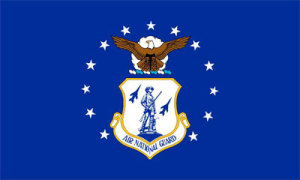Air National Guard History – Part 1
FORGING THE AIR NATIONAL GUARD
Read more of this series
Part 1 | Part 2 | Part 3 | Part 4
 An excerpt adapted from Chapter II of The Air National Guard: A Short History, by Dr. Charles J. Gross, National Guard Bureau Historical Services Division, 1994
An excerpt adapted from Chapter II of The Air National Guard: A Short History, by Dr. Charles J. Gross, National Guard Bureau Historical Services Division, 1994
The Air National Guard as we know it today — a separate reserve component of the United States Air Force — was a product of the politics of postwar planning and inter service rivalry during World War II.
The men who planned and maneuvered for an independent postwar Air Force during World War II didn’t place much faith in the reserves, especially the state-dominated National Guard. On the contrary, they were determined to build the largest and most modern standing force possible. They assumed that future wars would be short and highly destructive affairs decided by the ability of one side to deliver massive aerial firepower on an enemy’s heartland. They were convinced that reserves could not operate complex modern weapons without extensive post-mobilization training.
Reserves did not play a prominent role in their vision of the postwar Air Force. For its part, the Guard had a well-established stake in aviation. It had formed 29 observation squadrons between World War I and World War II.
But, domestic politics and American history forced them to significantly alter their plans. Determined not to be excluded from the post-war U.S. military establishment, the National Guard flexed its considerable political muscle during World War II. It forced the War Department (including the Army Air Forces) to retain it as the nation’s primary reserve force once the war was over.
Dramatic military budget cuts by President Harry S. Truman after V-J Day and his determination to split defense dollars evenly among the Army, Navy, and Air Force compelled the latter to plan for a far smaller active duty force than it had envisaged during World War II. The reserve components had to help fill the gap.
Consequently, in the late 1940s, the Air Force found itself stuck with the Air Guard against its best professional judgment. The ANG would be manned by some 58,000 personnel. Its primary units would be 84 flying squadrons, mostly fighters. Air defense of the continental U.S. was its main mission.
A separate National Guard aviation program began to emerge in 1946 as individual units obtained federal recognition. But, the Air Guard’s official birth date was 18 September 1947, the same day the Air Force became a separate service.
There was little trust and understanding between the active duty USAF and the ANG. Although it looked good on paper, one Air Force general referred to it as “flyable storage.” Other observers called its units state-sponsored flying clubs. The Air Force and the National Guard Bureau (NGB) spent the late 1940s fighting over who was in charge. Essentially, that question was resolved in 1950 when the Army and Air Force strengthened the power of the ANG and Army National Guard division chiefs to administer their organizations in response to the directives of their respective services.
The Korean War was a turning point for the U.S. military establishment including the Air Guard. Some 45,000 Air Guardsmen, 80 percent of the force, were mobilized. That callup exposed the glaring weaknesses of the ANG. Units and individuals lacked specific wartime missions. Their equipment, especially aircraft, was obsolete. Their training was usually deplorable. Once mobilized, they proved to be almost totally unprepared for combat. Guard nits were assigned almost at random to active duty, regardless of their previous training and equipment. Many key Air Guardsmen were stripped away from their units and used as fillers elsewhere in the Air Force. It took months and months for them to become combat ready. Some units never did.
Eventually, the mess was sorted out. The recalled Guardsmen contributed substantially to the air war in Korea and to the USAF’s global buildup for the expected military confrontation with the Soviet Union. However, the initial fiasco forced the Air Force to achieve an accommodation with the Air Guard and to thoroughly revamp its entire reserve system.
Please check back next week for part 2 of the 4 part series…
